The Four Mythological Symbols of China
In ancient Chinese astronomy, the sky ecliptic was divided into four sections. Each of these sections contained seven mansions, and together they formed the 28 Mansions. The 28 Mansions may be considered to be equivalent to the zodiacal constellations in Western astronomy, although they reflect the movement of the Moon through a sidereal month rather than the Sun in a tropical year. This enabled the ancient Chinese to mark the travelling positions of the Sun and the Moon, as well as to determine the time and seasons. Each section of the sky is assigned to a mythological creature, collectively known as the Four Symbols. These creatures are the Azure Dragon of the East, the White Tiger of the West, the Black Tortoise of the North, and the Vermillion Bird of the South. Apart from their astronomical significance, each of the Four Symbols is surrounded by various mythological associations.
According to the archaeological evidence, the concept of the Four Symbols may have existed as early as China’s Neolithic period (some 6,000 years ago). This is based on some clam shells and bones forming the images of the Azure Dragon and the White Tiger that were found in a tomb in Henan. In addition, it is claimed that one of the artefacts from the tomb of the Marquis Yi of Zeng (c. 433 B.C.) is a lacquer-painted wardrobe with the patterns of the Four Symbols and 28 Mansions.
The Azure Dragon is the mythological creature in the East, as it is said that when the seven mansions in that area (Horn, Neck, Root, Room, Heart, Tail, and Winnowing Basket) are joined up, they form the shape of a dragon. The Azure Dragon corresponds to the season of spring. As the dragon is considered by the Chinese as the noblest of animals, it is the head of the Four Symbols. Although Chinese dragons are commonly associated with water, the Azure Dragon is the exception, as its element is wood. In Chinese mythology, the dragon is regarded as a fearsome and mighty creature. Yet, unlike their Western counterparts, Chinese dragons are believed to be just, benevolent, and bringers of wealth and good fortune.
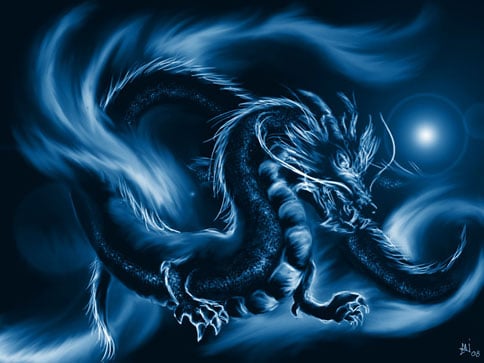
The Azure Dragon of the East. Image source.
The mythological creature in the West is the White Tiger, and its seven mansions are the Legs, Bond, Stomach, Hairy Head, Net, Turtle Beak and Three Stars. The White Tiger corresponds to the season of autumn. The White Tiger’s element is metal, and it was held to be the God of War. In this capacity, the White Tiger was seen as a protector and defender, not just from mortal enemies, but also from evil spirits.
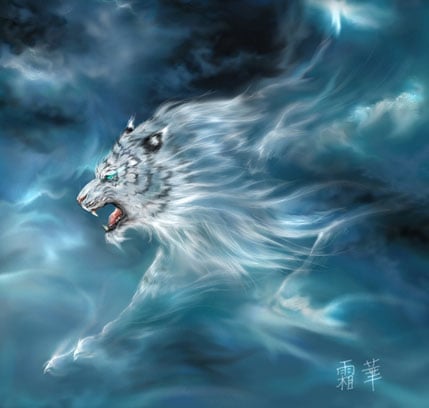
The White Tiger of the West. Image Source.
In the North, the mythological creature in the Black Tortoise, and its seven mansions are the Dipper, Ox, Girl, Emptiness, Rooftop, Encampment and Wall. The Black Tortoise corresponds to the season of winter. The element of the Black Tortoise is water, and this mythological creature is commonly associated with longevity and wisdom (just as these virtues are traditionally attributed to ordinary tortoises in Chinese mythology).
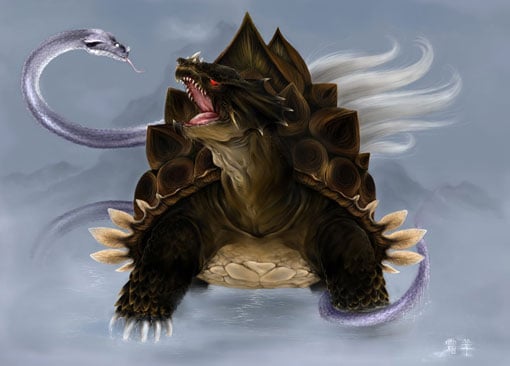
The Black Tortoise of the North. Image Source.
The mythological creature in the South is the Vermillion Bird, and its seven mansions are the Well, Ghosts, Willow, Star, Extended Net, Wings and Chariot. The Vermillion Bird corresponds to the season of summer. Interestingly, the Vermillion Bird has been considered to be identical to the phoenix. The phoenix is traditionally associated with fire, and this is also the case with the Vermillion Bird. As a mythological creature, the phoenix is considered as a symbol of good luck.
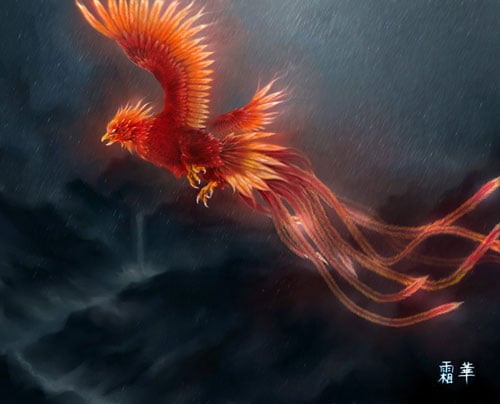
The Vermillion Bird of the South. Image source.
Within the Four Symbols of ancient China, astronomy and mythology co-existed side by side and may be seen as a harmonious fusion of science and art. By studying these mythological creatures, one is able not only to learn about the scientific advances of the ancient Chinese, but also their belief system and the way they perceived and explained the world they lived in.
Featured image: The Four Symbols. Photo source.
By Ḏḥwty
References
cultural-china.com, 2010. The Azure Dragon. [Online]
Available at: http://www.cultural-china.com/chinaWH/html/en/Traditions991bye1204.html
cultural-china.com, 2010. The Black Tortoise. [Online]
Available at: http://www.cultural-china.com/chinaWH/html/en/Traditions991bye1207.html
cultural-china.com, 2010. The Four Symbols and Twenty-Eight Mansions. [Online]
Available at: http://www.cultural-china.com/chinaWH/html/en/13Traditions991.html
cultural-china.com, 2010. The Vermilion Bird. [Online]
Available at: http://www.cultural-china.com/chinaWH/html/en/Traditions991bye1206.html
cultural-china.com, 2010. The White Tiger. [Online]
Available at: http://www.cultural-china.com/chinaWH/html/en/Traditions991bye1205.html
Schumacher, M., 2014. Shijin (Shishin) - Four Legendary Chinese Creatures Protecting the Four Compass Directions. [Online]
Available at: http://www.onmarkproductions.com/html/ssu-ling.shtml
Wikipedia, 2014. Four Symbols (China). [Online]
Available at: http://en.wikipedia.org/wiki/Four_Symbols_(China)
Wikipedia, 2014. Twenty-Eight Mansions. [Online]
Available at: http://en.wikipedia.org/wiki/Twenty-eight_mansions


















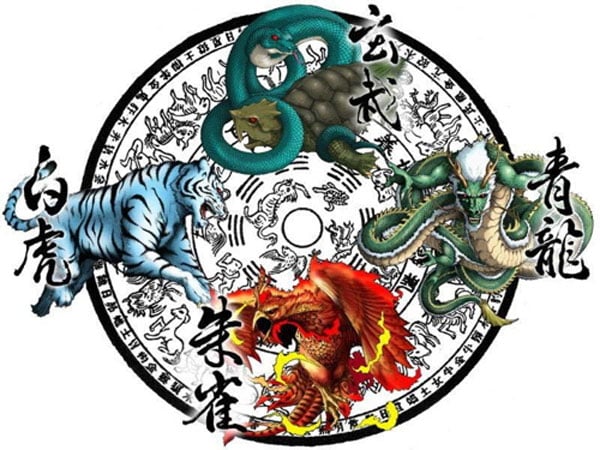

Comments
@Tsurugi - In Taoist (Daoist) philosophy everything in the Universe is made from one or a combination of the 5 elements. Earth, Metal, Water, Wood and Fire.
This includes the human body and spirit. (The study of WundangShang Taiji health and martial arts practices place emphasis on stimulating these elements within your body / psychy for different effects.)
In Wudang Taoist Theory / Legend Earth is represented by the Tiger, Metal by the snake, Water by the Turtle / Tortoise, Wood by the Dragon and Fire by the Vermillion / Pheonix bird. These elements / animals also form the basis of Wudang Wu Xing Nei Gong (5 animals Kung Fu).
It is believed full understanding of these 5 elements and their combinations can lead to almost 'super human powers' (As in legends of Taoist / Taiji Masters) and mastery of Alchemy.
Sources: Wudang Xuan Wu Pei Masters and training material.
Not sure what you mean when you say "elements"...do you mean the various numbers that seem to be present in many different mythologies, such as the 4, 7, and 12 in the myths you were talking about?
I too have noticed the commonalities in mythology across the globe and throughout history, linking cultureIt's and peoples separated by huge gulfs of space and time. It's fascinating, and seems to me to point to a single origin for these types of tales....an origin buried deep in the mists of prehistory.
The numbers usually seem to have their basis in astronomical conditions or specific mathematical principals related to the basic structure or functioning of the physical universe. I do not know why this should be, however.
4 may be indicative of the cardinal directions, as was said earlier. It could also be related to the 4 dimensions of material existence: three spatial dimensions and one of duration, or time.
12 may be precessional, referring to the constellations of the zodiak and the corresponding 12 ages of the Great Year...or may be a reference to the Lunar calendar and the number of times the moon makes a complete orbit of the earth during one complete orbit around the sun.
7 is more obscure(occulted?). It could be, perhaps the proper number of earth's orbital track in the Sol system, if one were to count from the outside in?
1)Pluto 2)Neptune 3)Uranus 4)Saturn 5)Jupiter 6)Mars 7)Earth....
It is said, in the teachings of Buddhism, that 7 is the "number of ascension"; it is also said that upon his birth, Buddha took seven steps. If one were to view the Sol system from the outside going in, much like an alien visitor would see it on approach, it could be construed as an ascent towards the light(the sun), and each planetary orbit crossed would be one "step"....seven steps lands the Buddha on earth.
Aside from that, 7 may also relate to fundamental physical characteristics in the following way: Top, Bottom, Front, Back, Left, Right, Center. Every physical object in the universe has these seven funamental characteristics.
Also the human body: two arms, two legs, head, torso, genitals. Additionally, there are 7 openings into the human head: two eyes, two nostrils, two ears, and mouth.
There are other, more tenuous connections, but I think the above are the principals. Hope that's what you were looking for! :)
Hmm, I don't know much about that but 4 sections in the sky symbolizes north,south,east,west. And 7x4=28 mansions may symbolize stars, planets, galaxies, maybe longevity... That's the way the ancients' giving information method:symbolizing.
I don't know its reason why is it important, I've read many myths but most of people and authors think they're just a tale so no one explains why some objects in common in myths.hope someone explains in next comments.
I also think there are connections between cultures and ancient wisdom (even if I prefer to avoid syncretism, at least till we'll go as backward as necessary to find when all started).
But I'd like to know if in the Chinese tradition is there a similar myth that explain the reason why these elements are considered so important. Thanks.
Ture
i think that is. most of myths, somehow, share the same things.
Pages